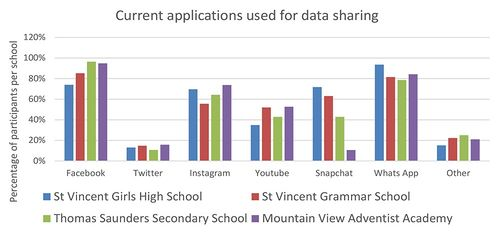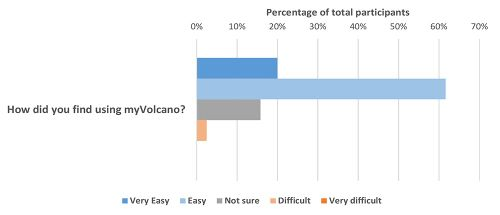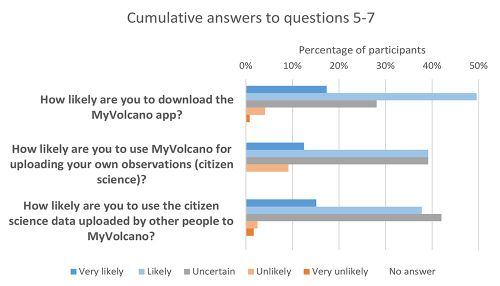OR/17/045 Findings from the school visits
| Duncan, M, Mee, K, Hicks, A, Engwell, S, Robertson, R, Forbes, M, Ferdinand, I, Jordan, C, and Loughlin, S. 2017. Using the 'myVolcano' mobile phone app for citizen science in St. Vincent and the Grenadines: a pilot study. British Geological Survey Open Report, OR/17/045. |
Worksheets were completed by 120 students across the four secondary schools. A summary of questionnaire results is given in Appendix 5 - Summary of responses from all school visits, with the main findings discussed in the following sections. [NB: Students at one school had their own laptops which may skew some results.
Current mobile phone use and data sharing applications
Of all the students’ responses, 105 (88%) said that they owned a smartphone. Similar to the stakeholder workshop participants, the dominant operating system is Android (Figure 13).

In terms of current applications for data sharing, the dominant apps used across all of the schools were Facebook and WhatsApp (Figure 14). There was, however, a dominance of SnapChat users amongst the Girls’ High School students (72% of participants) compared with the other schools, which could be partly explained by their access to iOS (SnapChat was primarily designed for this platform). Thirteen participants (28%) from the Girls’ High School stated that they used iOS devices, compared to only 6 (26%), 3 (24%) and 2 (17%) in the St. Vincent Grammar School, Thomas Saunders Secondary School and Mountain View Adventist Academy, respectively. In the case of Mountain View Academy, only 11% of the participants mentioned SnapChat. SnapChat is a self-deleting platform, so arguably does not lend itself well to citizen science observations.
Students mentioned a much greater variety of other applications they used for sharing information compared with the workshop participants, including Pinterest, email (Gmail and Outlook), Skype, tumblr, imo (free video calls and chat), Messenger (Facebook), kik (instant messaging), Aviary Instasize (photo editors). What can be interpreted from this is that students are motivated users in terms of applications for sharing different types of media: text, pictures, videos, but that unless myVolcano complements or integrates with existing mechanisms for sharing, it may be challenging to motivate students to use another application, unless it does something more than those they already have access to. A way of addressing this might be to design citizen science experiments based around using myVolcano that compliment or can be integrated into the school curriculum.

Likelihood of downloading and using myvolcano and observations
It was positive to note, particularly with regard to motivating students to use myVolcano, that most students (82% of the total 120 who took part) stated that they either found the app ‘very easy’ or ‘easy’ to use (Figure 15). In some of the schools internet access limited the extent to which students were able to test the app, for instance in the Girls’ High School and to a lesser extent in the Thomas Saunders Secondary School. Indeed, there was a slight decrease in ‘easy’ and ‘very easy’ responses for the Girls’ High School: 76% compared with 84–86% for the other schools. The Girls’ High School also had the highest proportion of uncertainty around the ease of use, with 24% compared to a range of 5% (Mountain View Academy) to 14% (Thomas Saunders Secondary School) for the other three schools. In general, however, students either perceived or could demonstrate that myVolcano was easy to use (Figure 15).

In terms of whether or not students would download and make use of the app, either by uploading their own observations or the observations used by others, there was generally a positive response, but with an increasing degree of uncertainty across the answers (Figure 16); for instance, whilst 52% of students are either ‘very likely’ or ‘likely’ to use myVolcano to upload their own citizen science observations, 39% were unsure (the same value as those who ticked ‘likely’) and students were even more unsure (42%), when it came to them making use of the observations. This uncertainty actually surpassed those who said they were ‘likely’ to make use of the observations when treated separately from those who answered ‘very likely’. These answers to some extent support the findings of the workshop, which emphasise a positive interest in the app, but a limited enthusiasm for adopting it without significant modifications.
